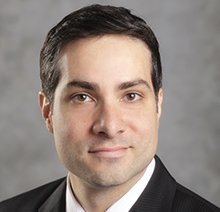Interview With Dr. Nicholas Barone of the University of Virginia

Dr. Barone is an assistant professor in the Communication Sciences and Disorders Program in the Human Services Department, Curry School of Education and Human Development at the University of Virginia. His research and clinical areas include voice disorders, dysphagia and neuroanatomy and physiology. He is the Director of the Neurophysiology of Voice, Communication, and Cognition (NeuroVoice) Lab where he uses functional Near Infrared Spectroscopy (fNIRS) to study changes in cortical activation patterns related to learning and voice production and perception.
Note: You should consult with your doctor or speech pathologist for recommendations on treatment. The views and opinions expressed in this article are those of Dr. Barone and do not necessarily reflect the official policy or position of SpeechPathologyMastersPrograms.com
How did you become interested in how changing one’s voice to use it in a new way impacts the brain?
During treatment of a voice disorder, quantifying changes in voice quality has historically been accomplished through auditory-perceptual evaluation using instruments like the CAPE-V (Consensus Auditory Perceptual Evaluation of Voice) and the GRBAS scale which are highly subjective. I first became interested in this topic during my Master’s education and looked at how Acoustic and Aerodynamic measures may be used to measure changes in the voice, however, many of the measures can be unreliable. During my PhD training under Dr. Christy Ludlow, we started to think about another way to measure vocal quality acquisition in the brain related to mastery of a vocal quality, which is the primary goal of many types of treatment. We were interested in new, more easily accessible equipment to look at cortical changes and therefore used functional Near Infrared Spectroscopy to test for changes. Using fNIRS allowed us see what was happening cortically in the lab using lasers on the scalp and gave us more freedom to examine vocal tasks. So, as a first step, we examined how vocal training can impact the voice and brain of vocal performance students before and after their first semester of training. The findings for those studies are still being analyzed, but we came to the realization that using fNIRS may give us a tool that can look for the changes in brain activation associated with learning and mastering new vocal tasks and may have some clinical application down the road.
How has our understanding of how one can change their voice if needed grown over time? What technologies have been most important to broadening our understanding?
We have a pretty good understanding of how the brain activation changes from when we first try a new motor task to when we have mastered it. In general, motor learning research has shown that early on in learning when the task is relatively more difficulty to the person, the brain has more diffuse activation recruiting other areas of the brain, while using perceptual feedback, to aid in the learning process. Once the task has been mastered, the brain has more focal activation relying on feedforward system to accomplish the task. This has been theorized has a means for language acquisition in small children, but has not been tested in vocal quality acquisition.
Historically, fMRI has been the primary means to examine brain function. However, fMRI is very costly, requires a trained technician, and does not lend itself to vocal tasks because the movement of the head while vocalizing can interfere with the recording and is difficult (not impossible) to minimize. These issues can make access to fMRI limited for research and clinical application. A possible solution is using fNIRS to examine changes at the cortical level. Using lasers, similar to those found in Pulse oximeters, we can see the same changes in hemoglobin that fMRI examines, while having better temporal resolution. At this time, fNIRS is limited to examinations of superficial cortical activation and therefore does not have the spatial resolution and ability to measure deep brain activation of fMRI, but at a fraction of the cost, it is a promising new technology for examining functional activation in the brain.
What type of patients are you studying and how are you measuring these changes?
We have not begun measuring patients right now, we are still examining the cortical changes related to learning in the cerebrum related to learning new tasks. Our hope is that these early studies will show that these changes that occur from acquisition to mastery are identifiable and can be measured reliably, and will lead to the creation of a new instrument for objectively quantifying acquisition, mastery, and generalization of a newly learned motor behavior, such as learning a new therapeutic voice quality. Patients with muscle tendon dysphonia, vocal fold lesions, vocal fold paresis and others that require the learning of a new habitual voice quality would benefit from this research.
As stated in the previous answer, we are using fNIRS for this research.
What do the changes that you have found or may find mean for patients?
If we can show that we can measure when a patient has cortically acquired the ability to complete a new motor task (new therapeutic voice quality) habitually (by showing changes from pre- and post-therapy), that could have implication for dosage of therapy (number therapy sessions or how long therapy should last) to ensure that a patient can go out on their own without having to come back to receive treatment for the same issues repeatedly.
Any other interesting projects going on in the lab? How are new research initiatives chosen?
We are looking at changes in cortical activation related to categorical perception of a non-native phoneme in English speakers using fNIRS which may have some interesting findings for how brain activity changes during code switching between native and learned languages. We are also exploring how voice professionals categorize different voices using commonly used voice quality terms. Finally, we are examining if certain aspects of voice quality are categorically perceived similar to how we perceive consonant phonemes.
Choosing new research initiatives to a two-fold process. My NeuroVoice Lab has a mission to encourage and allow undergraduate and graduate students with an interest in research to be able to use the space and receive mentorship on projects that they are curious about. That has been successful with 2 undergraduates having completed independent studies with their finding being presented at the ASHA convention (2017 and coming up this year in Boston) and international conferences (fNIRS Biannual Conference 2018, Tokyo Japan). I also have a research agenda that that I am completing.
What aspect of your research are you most proud of?
I am really proud of the students I have in my lab and how they have risen to the challenges that the research presents and have been great. We have 5 graduate student research assistants and 2 undergraduate volunteers that not only run some of the fNIRS studies on their own (due to IRB restrictions), but have been so successful at initiating and completing independent research projects. They all contribute to the design and implementation of the projects, and are part of the process as I design and implement my own research agenda. We are trying to forge a new way forward in how we quantify and study the voice and I’m proud to lead these student researchers as they come through my lab on their way to their professional careers.
I am also proud of how my Department (Human Services) , School (Curry School of Education and Human Development) and the University of Virginia has supported my research goals.
What is your advice for SLP graduate students?
I tell my graduate students that there are 2 keys to becoming a great clinician. The first is that they need to be informed consumers of research if they want to be able to implement the newest evidence based practices. A great way to become more informed about the research they read is by experiencing what it takes to complete a project from conception to analysis to dissemination. Second, I teach Anatomy and Physiology to both undergraduates and graduate students (Neuroanatomy and Neurophysiology to the Grads) and always tell my students that those courses create the foundation for all other knowledge and skills that you will obtain throughout your education. Put in the work so that you can build your temple of knowledge and skills on a strong foundation that can withstand and accommodate our ever changing field.
Sponsored online speech pathology programs

Online MS: Pursue SLP Certification. Study FT/PT
Speech@Emerson enables you to earn an MS online and pursue SLP certification in as few as 20 mos. Learn the same curriculum as the on-campus program. Study FT or PT.
- Prepares you to pursue certification as an SLP generalist
- In-person clinical placements at faculty-approved partner sites
- As few as 20 months to complete
SPONSORED

Want to Become an SLP? Earn an MS Online at NYU
NYU Steinhardt’s online master of science program in Communicative Sciences and Disorders prepares aspiring speech-language pathologists with a comprehensive professional education.
- Prepares students to pursue SLP licensure
- Accredited by ASHA’s Council on Academic Accreditation
- As few as six terms to complete
- Full-time and part-time plans of study
SPONSORED

Online MS in Speech-Language Pathology from Pepperdine University
Pepperdine University’s online Master of Science in Speech-Language Pathology program combines a robust, innovative curriculum rooted in Christian values with a full-time or part-time option that features online learning, on-campus intensive experiences, and comprehensive clinical field practicums to prepare skilled, compassionate students for careers as speech-language pathologists.
- Full-time (five trimesters) or part-time (eight trimesters) options available.
- No GRE scores required.
- 400+ supervised, clinical learning hours are done at schools/clinics local to students
- Three onsite experiences build a sense of camaraderie and community throughout the program
SPONSORED

